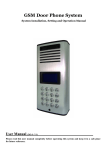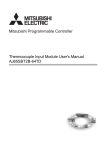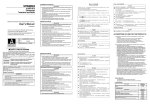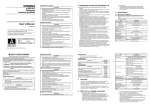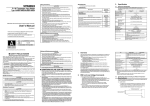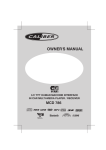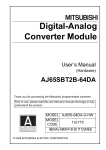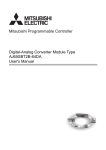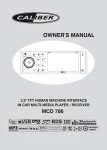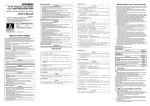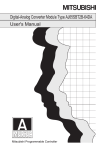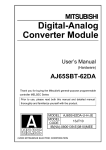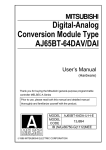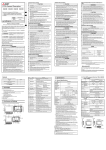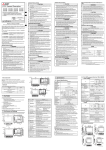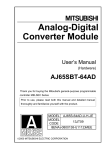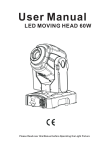Download Thermocouple Input Module User`s Manual
Transcript
Thermocouple Input
Module
User’s Manual
(Hardware)
AJ65SBT2B-64TD
Thank you for purchasing the Mitsubishi programmable controller .
Prior to use, please read this and relevant manuals thorougly to fully
understand the product.
MODEL AJ65S-64TD-U-HW
MODEL
13JY76
CODE
IB(NA)-0800419-E(1112)MEE
© 2009 MITSUBISHI ELECTRIC CORPORATION
SAFETY PRECAUTIONS
(Read these precautions before using this product.)
Before using this product, please read this manual and the relevant manuals
carefully and pay full attention to safety to handle the product correctly.
These precautions apply only to this equipment. Refer to the user's manual of the
CPU module to use for a description of the programmable controller system safety
precautions.
In this manual, the safety precautions are classified into two levels:
"
WARNING" and "
CAUTION".
WARNING
Indicates that incorrect handling may cause
hazardous conditions, resulting in death or severe
injury.
CAUTION
Indicates that incorrect handling may cause
hazardous conditions, resulting in minor or moderate
injury or property damage.
Under some circumstances, failure to observe the precautions given under
"
CAUTION" may lead to serious consequences.
Observe the precautions of both levels because they are important for personal
and system safety.
Make sure that the end users read this manual and then keep the manual in a safe
place for future reference.
A-1
[Design Precautions]
WARNING
In the case of a communication failure in the network, data in the master
module are held.
Check the communication status information (SB, SW) and configure an
interlock circuit in the sequence program to ensure that the entire system will
operate safely.
CAUTION
Do not install the control lines or communication cables together with the
main circuit lines or power cables.
Keep a distance of 100mm (3.94 inches) or more between them.
Failure to do so may result in malfunction due to noise.
[Installation Precautions]
CAUTION
Use the programmable controller in an environment that meets the general
specifications in this manual.
Failure to do so may result in electric shock, fire, malfunction, or damage to
or deterioration of the product.
For protection of the switches, do not remove the cushioning material before
installation.
Securely fix the module with a DIN rail or mounting screws. Tighten the
screws within the specified torque range.
Undertightening can cause drop of the screw, short circuit or malfunction.
Overtightening can damage the screw and/or module, resulting in drop, short
circuit, or malfunction.
Do not directly touch any conductive part of the module.
Doing so can cause malfunction or failure of the module.
A-2
[Wiring Precautions]
CAUTION
Shut off the external power supply for the system in all phases before wiring.
Failure to do so may result in damage to the product.
Ground the FG terminals to the protective ground conductor dedicated to the
programmable controller.
Failure to do so may result in malfunction.
Tighten any unused terminal screws within the specified torque range (0.42
to 0.50N•m).
Failure to do so may cause a short circuit due to contact with a solderless
terminal.
Use applicable solderless terminals and tighten them within the specified
torque range.
If any spade solderless terminal is used, it may be disconnected when the
terminal screw comes loose, resulting in failure.
Check the rated voltage and terminal layout before wiring to the module, and
connect the cables correctly.
Connecting a power supply with a different voltage rating or incorrect wiring
may cause a fire or failure.
Tighten the terminal screw within the specified torque range.
Undertightening can cause short circuit or malfunction. Overtightening can
damage the screw and/or module, resulting in drop, short circuit, or
malfunction.
Prevent foreign matter such as dust or wire chips from entering the module.
Such foreign matter can cause a fire, failure or malfunction.
Place the cables in a duct or clamp them.
If not, dangling cable may swing or inadvertently be pulled, resulting in
damage to the module or cables or malfunction due to poor contact.
Do not install the control lines or communication cables together with the
main circuit lines or power cables. Failure to do so may result in malfunction
due to noise.
When disconnecting the cables from the module, do not pull the cable by the
cable part.
Loosen the screws of connector before disconnecting the cable.
Failure to do so may result in damage to the module or cable or malfunction
due to poor contact.
A-3
[Startup/Maintenance Precautions]
CAUTION
Do not touch any terminal while power is on.
Doing so may cause malfunction.
Shut off the external power supply for the system in all phases before
cleaning the module or retightening the terminal screws .
Failure to do so may cause the module to fail or malfunction.
Undertightening can cause drop of the screw, short circuit or malfunction.
Overtightening can damage the screw and/or module, resulting in drop, short
circuit, or malfunction.
Do not disassemble or modify the modules.
Doing so may cause failure, malfunction, injury, or a fire.
Do not drop or apply strong shock to the module.
Doing so may damage the module.
Shut off the external power supply for the system in all phases before
mounting or removing the module to or from the panel.
Failure to do so may cause the module to fail or malfunction.
After the first use of the product, do not mount/remove the terminal block to/
from the module more than 50 times. (IEC 61131-2 compliant)
Before handling the module, touch a grounded metal object to discharge the
static electricity from the human body.
Failure to do so may cause the module to fail or malfunction.
A-4
[Disposal Precautions]
CAUTION
When disposing of this product, treat it as industrial waste.
A-5
CONDITIONS OF USE FOR THE PRODUCT
(1) Mitsubishi programmable controller ("the PRODUCT") shall be used in
conditions;
i) where any problem, fault or failure occurring in the PRODUCT, if any,
shall not lead to any major or serious accident; and
ii) where the backup and fail-safe function are systematically or
automatically provided outside of the PRODUCT for the case of any
problem, fault or failure occurring in the PRODUCT.
(2) The PRODUCT has been designed and manufactured for the purpose of
being used in general industries.
MITSUBISHI SHALL HAVE NO RESPONSIBILITY OR LIABILITY
(INCLUDING, BUT NOT LIMITED TO ANY AND ALL RESPONSIBILITY
OR LIABILITY BASED ON CONTRACT, WARRANTY, TORT, PRODUCT
LIABILITY) FOR ANY INJURY OR DEATH TO PERSONS OR LOSS OR
DAMAGE TO PROPERTY CAUSED BY the PRODUCT THAT ARE
OPERATED OR USED IN APPLICATION NOT INTENDED OR
EXCLUDED BY INSTRUCTIONS, PRECAUTIONS, OR WARNING
CONTAINED IN MITSUBISHI'S USER, INSTRUCTION AND/OR
SAFETY MANUALS, TECHNICAL BULLETINS AND GUIDELINES FOR
the PRODUCT.
("Prohibited Application")
Prohibited Applications include, but not limited to, the use of the
PRODUCT in;
• Nuclear Power Plants and any other power plants operated by Power
companies, and/or any other cases in which the public could be
affected if any problem or fault occurs in the PRODUCT.
• Railway companies or Public service purposes, and/or any other cases
in which establishment of a special quality assurance system is
required by the Purchaser or End User.
• Aircraft or Aerospace, Medical applications, Train equipment, transport
equipment such as Elevator and Escalator, Incineration and Fuel
devices, Vehicles, Manned transportation, Equipment for Recreation
and Amusement, and Safety devices, handling of Nuclear or
Hazardous Materials or Chemicals, Mining and Drilling, and/or other
applications where there is a significant risk of injury to the public or
property.
A-6
Notwithstanding the above, restrictions Mitsubishi may in its sole
discretion, authorize use of the PRODUCT in one or more of the
Prohibited Applications, provided that the usage of the PRODUCT is
limited only for the specific applications agreed to by Mitsubishi and
provided further that no special quality assurance or fail-safe, redundant
or other safety features which exceed the general specifications of the
PRODUCTs are required. For details, please contact the Mitsubishi
representative in your region.
A-7
REVISIONS
* The manual number is given on the bottom right of the cover.
Print date
Jun., 2009
Dec., 2009
*Manual number
IB(NA)-0800419-A
IB(NA)-0800419-B
Apr., 2010
IB(NA)-0800419-C
Dec., 2010
IB(NA)-0800419-D
Dec., 2011
IB(NA)-0800419-E
Revision
First edition
Adittion
CONDITIONS OF USE FOR THE PRODUCT
Partial correction
SAFETY PRECAUTIONS, ABOUT MANUAL,
CHAPTER 1, Section 2.1, 2.2, Section 3.1,
Section 4.1, Section 5.2, 5.3, Section 6.1, 6.2,
CHAPTER 7
Partial correction
Back cover
Partial correction
CONDITIONS OF USE FOR THE PRODUCT,
SAFETY PRECAUTIONS, ABOUT MANUAL,
Section 2.1
Adittion
SAFETY PRECAUTIONS(Chinese)
Partial correction
Section 2.1, 4.1
This manual confers no industrial property rights or any rights of any other kind, nor does it
confer any patent licenses. Mitsubishi Electric Corporation cannot be held responsible for any
problems involving industrial property rights which may occur as a result of using the contents
noted in this manual.
© 2009 MITSUBISHI ELECTRIC CORPORATION
A-8
CONTENTS
1. OVERVIEW .................................................................................................... 1
2. SPECIFICATIONS .......................................................................................... 2
2.1 General Specifications ............................................................................. 2
2.2 Performance Specifications...................................................................... 4
3. PART NAMES AND SETTINGS ..................................................................... 8
3.1 Part Names .............................................................................................. 8
4. LOADING AND INSTALLATION .................................................................. 12
4.1 Handling Precautions ............................................................................. 12
5. DATA LINK CABLE WIRING ........................................................................ 14
5.1 Wiring Precautions ................................................................................. 14
5.2 CC-Link Dedicated Cable Connection Method....................................... 14
5.3 Connection of Terminating Resistor ....................................................... 14
6. WIRING ........................................................................................................ 15
6.1 Wiring Precautions ................................................................................. 15
6.2 Wiring with Thermocouple ...................................................................... 15
7. EXTERNAL DIMENSIONS ........................................................................... 16
A-9
ABOUT MANUAL
The following manual is also relevant to this product.
If necessary, place an order.
Relevant manual
Manual name
Thermocouple Input Module AJ65SBT2B-64TD User's Manual
CC-Link System Master/Local Module Type AJ61BT11/A1SJ61BT11
User's Manual
CC-Link System Master/Local Module Type AJ61QBT11/
A1SJ61QBT11 User's Manual
CC-Link System Master/Local Module User's Manual
Type AnSHCPU/AnACPU/AnUCPU/QCPU-A (A Mode)
Programming Manual (Dedicated Instructions)
MELSEC-L CC-Link System Master/Local Module User's Manual
Manual number
(Model code)
SH-080769ENG
(13JZ20)
IB-66721
(13J872)
IB-66722
(13J873)
SH-080394
(13JR64)
IB-66251
(13J512)
SH-080895ENG
(13JZ41)
COMPLIANCE WITH EMC AND LOW VOLTAGE DIRECTIVES
(1) Method of ensuring compliance
To ensure that Mitsubishi programmable controllers maintain EMC
and Low Voltage Directives when incorporated into other
machinery or equipment, certain measures may be necessary.
Please refer to one of the following manuals.
• User's manual for the CPU module or head module used
• Safety Guidelines
(This manual is included with the CPU module, base unit, or
head module)
The CE mark on the side of the programmable controller indicates
compliance with EMC and Low Voltage Directives.
(2) Additional measures
To ensure that this product maintains EMC and Low Voltage
Directives, please refer to one of the manuals listed under (1).
A-10
1. OVERVIEW
This user's manual explains the specifications, names of the
components and wiring for the AJ65SBT2B-64TD Thermocouple Input
Module (hereafter AJ65SBT2B-64TD) which are used as a remote
device station in a CC-Link system.
1
2. SPECIFICATIONS
2.1 General Specifications
The general specifications of the AJ65SBT2B-64TD are shown in the
following table.
Table 2.1 General specifications
Item
Operating
ambient
temperature
Storage
ambient
temperature
Operating
ambient
humidity
Storage
ambient
humidity
Specification
0 to 55
-20 to 75
10 to 90%RH, non-condensing
Frequency
Vibration
resistance
Shock
resistance
Operating
atmosphere
Operating
altitude *1
Installation
location
Overvoltage
category *2
Pollution
degree *3
Under
Compliant
intermittent
with JIS B
vibration
3502 and
IEC 61131-2
Under
continuous
vibration
Constant
Half
acceleration amplitude
5 to 8.4Hz
-
3.5mm
8.4 to150Hz
9.8m/s2
-
5 to 8.4Hz
-
1.75mm
8.4 to150Hz
4.9m/s2
-
-
Compliant with JIS B 3502 and IEC 61131-2
(147 m/s2, 3 times each in 3 directions X, Y, Z)
No corrosive gases
0 to 2000m
Inside a control panel
II or less
2 or less
2
Sweep
count
10 times
each in X,
Y, Z
directions
*1
*2
*3
Do not use or store the programmable controller under pressure higher than
the atmospheric pressure of altitude 0m. Doing so may cause malfunction.
When using the programmable controller under pressure, please consult
your local Mitsubishi Electric representative.
This indicates the section of the power supply to which the equipment is
assumed to be connected between the public electrical power distribution
network and the machinery within premises.
Category II applies to equipment for which electrical power is supplied from
fixed facilities. The surge voltage withstand level for up to the rated voltage of
300V is 2500V.
This index indicates the degree to which conductive material is generated in
terms of the environment in which the equipment is used.
Pollution level 2 is when only non-conductive pollution occurs. A temporary
conductivity caused by condensing must be expected occasionally.
3
2.2 Performance Specifications
The performance specifications for the AJ65SBT2B-64TD are shown in
the following table.
Table 2.2 Performance specifications
Item
Temperature sensor input
Measured temperature value
Applicable thermocouple and
measured temperature range
accuracy*1
Cold junction compensation
accuracy
(Operating ambient
temperature 25 10 )*1*2
Overall accuracy*1
Maximum resolution
Conversion speed*4
Sampling cycle*5
Absolute maximum input
Number of analog input points
Built-in terminating resistor
Number of writes to Flash
memory
CC-Link station type
Number of occupied stations
Connection cable
Withstand voltage
AJ65SBT2B-64TD
-270 to 1820
16-bit signed binary (-2700 to 18200: value rounded to one
decimal place 10)
Refer to Table 2.3 Applicable thermocouples and conversion
accuracies
1.0
See the calculation formula in *3.
B, R, S, N: 0.3
K, E, J, T: 0.1
640ms/4 channels
160ms/4 channels
5V
4 channels + Pt100 connection channel 2
Available (110 )
Up to 10,000 times
Remote device station
1 station (RX/RY: 32 points each, RWr/RWw: 4 points each)
CC-LInk dedicated cable
Between all power supply
systems and all
communication systems and
cold junction compensation
channels
Between thermocouple input
and all communication
systems and cold junction
compensation channels
Between thermocouple input
channels
4
500VAC for one minute
Table 2.2 Performance specifications
Item
AJ65SBT2B-64TD
Between all power supply
systems and all
communication systems and
cold junction compensation
channels
Isolation method
Between thermocouple input
and all communication
systems and cold junction
compensation channels
Noise immunity
Disconnection detection
Communic
ation part,
module
External
power
connection
supply part
system
Transformer isolation
Between thermocouple input
channels
Tested by a noise simulator with noise voltage of 500Vp-p,
noise width of 1 s, and noise frequency of 25 to 60Hz.
Available (for each channel)
7-point, 2-piece terminal block
M3 5.2 Tightening torque: 0.59 to 0.88N•m
Number of applicable solderless terminals: maximum 2
18-point, 2-piece terminal block
M3 5.2 Tightening torque: 0.59 to 0.88N•m
Number of applicable solderless terminals: maximum 2
Applicable wire size
0.3 to 2.0mm2
• RAV1.25-3 (JIS C 2805 compliant)
[Applicable wire size: 0.3 to 1.25mm2]
Applicable solderless terminal
• V2-MS3, RAP2-3SL, TGV2-3N
[Applicable wire size: 1.25 to 2.0mm2]
M4
0.7mm 16mm or more screw
Module mounting screw
(tightening torque range: 0.78 to 1.08N•m)
The module can also be mounted with a DIN rail.
Applicable DIN rail
TH35-7.5Fe, TH35-7.5AI (IEC 60715 compliant)
24VDC (20.4VDC to 28.8VDC)
External power supply
Inrush current: 1.5A 1.3ms
Current consumption: 0.12A (24VDC)
Weight
0.3kg
I/O part
*1
Except when noise is applied. To meet the accuracy, a warm-up (power
*2
When the module is mounted vertically and the ambient temperature for use
distribution) period of 30 minutes is required.
is from 0 to 15
or from 35 to 55 , the cold junction temperature
compensation accuracy is
*3
1.5 .
Calculate the overall accuracy by the following method.
(Overall accuracy) = (Conversion accuracy) + (Temperature characteristics)
(Operating ambient temperature variation)
+(Cold junction compensation accuracy)
5
The operating ambient temperature variation indicates a deviation of an
operating ambient temperature from a range of 25 5 .
Example) When using the thermocouple B (refer to Table 2.3) at an
operating ambient temperature of 35
and a measured temperature of
1000 , the overall accuracy is:
( 2.5 )+( 0.4 ) (35 -30 )+( 1 )= 5.5
*4
The conversion speed indicates the maximum period of time from when the
input temperature changes to when the measured temperature value of the
remote register is updated.
*5
The sampling cycle indicates a cycle that the measured temperature
value of a channel is updated.
6
Table 2.3 Applicable thermocouples and conversion accuracies
Applicable
thermocouple
type
Measured temperature
range*1
0 to 600
B
R
S
----- *3
*2
600 to 1700
----- *3
Max. temperature
error at ambient
temperature 55
----- *3
2.5
0.4
12.5
----- *3
----- *3
----- *3
-50 to 0
----- *3
----- *3
----- *3
*2
2.0
0.4
12.0
1600 to 1760
0 to 1600
----- *3
----- *3
----- *3
-50 to 0
----- *3
----- *3
----- *3
*2
0 to 1600
-270 to -200
2.0
0.4
12.0
----- *3
----- *3
----- *3
----- *3
----- *3
0.06
or
0.3% of measured
temperature whichever the greater
15.5
----- *3
*2
-200 to 0
K
*2
0 to 1200
1200 to 1370
0.5
or
0.25% of measured
temperature whichever the greater
----- *3
-270 to -200
----- *3
-200 to 0
*2
0 to 900
*2
E
900 to 1000
0.5
or
0.25% of measured
temperature whichever the greater
----- *3
-210 to -40
*2
-40 to 750
750 to 1200
-270 to -200
*2
0 to 350
*2
350 to 400
-200 to 0
0 to 1250
1250 to 1300
----- *3
----- *3
0.06
or
0.3% of measured
temperature whichever the greater
15.5
0.06
or
0.02% of
measured temperature whichever
the greater
6.75
----- *3
----- *3
----- *3
----- *3
5.625
----- *3
----- *3
----- *3
----- *3
----- *3
0.06
or
0.3% of measured
temperature whichever the greater
15.5
0.5
or
0.25% of measured
temperature whichever the greater
----- *3
*2
----- *3
0.06
or
0.02% of
measured temperature whichever
the greater
*2
N
9.0
----- *3
----- *3
----- *3
-270 to -200
0.06
or
0.02% of
measured temperature whichever
the greater
0.5
or
0.25% of measured
temperature whichever the greater
----- *3
-200 to 0
T
*1
Temperature characteristic
(Per operating ambient
temperature variation of 1 )
1700 to 1820
1600 to 1760
J
Conversion accuracy
(At operating ambient temperature
25 5 )
0.5
or
0.25% of measured
temperature whichever the greater
----- *3
0.06
or
0.02% of
measured temperature whichever
the greater
2.625
----- *3
----- *3
----- *3
----- *3
0.06
or
0.3% of measured
temperature whichever the greater
15.5
0.06
or
0.02% of
measured temperature whichever
the greater
9.375
----- *3
----- *3
If a value input from the thermocouple is outside the measured temperature
range given in this table, it is handled as the maximum or minimum value of
the measured temperature range.
*2
The accuracies are applied only in the temperature ranges of Class 1 to 3
(shaded areas) in JIS C1602-1995.
To meet the accuracy, a warm-up (power distribution) period of 30 minutes is
required.
*3
Temperature can be measured, however; the accuracy is not guaranteed.
7
3. PART NAMES AND SETTINGS
3.1 Part Names
This section explains the names of the components for the AJ65SBT2B64TD.
DA
DG
DB
+24V
SLD
FG
24G
CH1
+
CH1
-
CH3
+
RTD
CH3
-
RTD
RTD
CH2
+
RTD
CH2
-
CH4
+
NC
CH4
-
Figure 3.1 Appearance of the AJ65SBT2B-64TD
8
TEST
NC
TEST
NC
NC
Table 3.1 Part names
No.
Name
Description
On: Power supply on
Off: Power supply off
On:
Normal operation
Flashing: Indicates that out of average processing
setting range error or faulty hardware, or
Normal
RTD Pt100 is disconnected, or user range
mode
read error.
Off:
Indicates that 24VDC power supply
interrupted, watchdog timer error occurred.
On:
Indicates that the SELECT/SET switch is in
RUN
the SET position.
LED
Flashing: Indicates that the offset value or the gain
value is out of the setting range,or the gain
Test
value is less than 10 greater than the offset
mode
value,or faulty hardware, or RTD Pt100 is
disconnected, or write error for Flash
memory.
Off:
Indicates that the SELECT/SET switch is in
the SELECT or center position.
L RUN
On: Normal communication
LED
Off: Communication cutoff (time expiration error)
On:
Indicates that station number setting
is outside the range.
Flashing regularly:
Indicates that station number setting
was changed from that at power-on.
L ERR.
Flashing irregularly:
Indicates that the terminating
LED
register is not connected. The
module or CC-Link dedicated cable
is affected by noise.
Off:
Indicates normal communication.
Normal
Always off.
TEST
mode
CH
Turns on when the TEST terminal is short-circuited.
OFFSET Test
The LEDs lit change every time the SELECT/SET
GAIN
mode
switch is moved to SELECT.
When the switch is moved to SELECT during the test mode, the offset value
or gain value of the specified channel can be adjusted.
Moving the switch to SET determines the offset value or gain value.
Used to adjust the offset value and gain value of the channel specified by
the SELECT/SET switch.
PW LED
1
Operating
status
indication
LED
2
Offset/gain
adjusting
LEDs
3
SELECT/
SET switch
4
UP/DOWN
switch
9
Table 3.1 Part names
No.
5
Name
Station
number
setting
switches
Description
Use the switches in STATION NO. "10", "20" and "40" to set the tens place
of the station number.
Use the switches in STATION NO. "1", "2", "4" and "8" to set the ones place
of the station number.
The switches are all factory-set to off.
Set the station number within the range from 1 to 64.
Setting any other number than 1 to 64 will result in an error, with the
"L ERR." LED on.
The switches cannot set the same station number to two or more stations.
Station
number
1
2
3
4
40
OFF
OFF
OFF
OFF
Tens place
20
OFF
OFF
OFF
OFF
10
OFF
OFF
OFF
OFF
8
OFF
OFF
OFF
OFF
Ones place
4
2
OFF
OFF
OFF
ON
OFF
ON
ON
OFF
1
ON
OFF
ON
OFF
10
11
OFF
OFF
OFF
OFF
ON
ON
OFF
OFF
OFF
OFF
OFF
OFF
OFF
ON
64
ON
ON
OFF
OFF
ON
OFF
OFF
(Example) To set the station number to "32", set the switches as indicated
below.
Station
number
32
6
Use
prohibited
40
OFF
Tens place
20
10
ON
ON
8
OFF
Ones place
4
2
OFF
ON
1
OFF
Do not use.
Terminal block for transmission and module power supply
Terminal
Description
DA
7
Terminal
block for
transmission
and
module
power
supply
DB
DG
Connection terminal for CC-Link dedicated cable
SLD
FG
+24V
24G
Connection terminal for grounding to the protective
conductor
*SLD and FG terminals are connected inside of the
module.
Connection terminal for extermal power supply
10
Table 3.1 Part names
No.
Name
Description
Used to connect I/O signals.
8
Terminal
Description
CH +
CH -
Connection terminal for CH thermocouple or
compensation lead wire
TEST
Connection terminal for short circuit at TEST mode
RTD
Connection terminal for RTD Pt100
NC
Reserved
Terminal
block for
analog input
signal
DIN rail
Used to install the module to the DIN rail.
hook
L TER. (Line
Turned on to use the terminating resistor built in the AJ65SBT2B-64TD.
10 Termination) Turned on when the AJ65SBT2B-64TD is used in the end of the network.
switch
9
*
The transmission speed is automatically set according to the setting of the
master module.
11
4. LOADING AND INSTALLATION
4.1 Handling Precautions
The following is an explanation of handling precautions of the
AJ65SBT2B-64TD.
(1) Tighten screws (such as a module fixingscrew) within the tightening
torque range specified in the tablebelow.
Table 4.1 Tightening torque range
Screw location
Module mounting screw (M4 screw)
Terminal block terminal screw (M3 screw)
Terminal block installation screw (M3.5 screw)
Tightening torque range
0.78 to 1.08N•m
0.59 to 0.88N•m
0.68 to 0.98N•m
(2) To prevent defect during transportation, a protective film is attached
on the surface of the module. Remove the film before using the
module.
(3) When using the DIN rail, pay attention to the following.
(a) Applicable DIN rail type (Compliant with IEC 60715)
TH35-7.5Fe
TH35-7.5Al
(b) DIN rail installation screw pitch
When installing a DIN rail, tighten the screws at a pitch of
200mm or less.
(4) When mounting the AJ65SBT2B-64TD to the DIN rail, press the
centerline of the DIN rail hook at the bottom of the module with your
finger until it clicks.
DIN rail
DIN rail hook
Figure 4.1 Installation to DIN rail
12
(5) For the use with the AJ65SBT2B-64TD, refer to the master module
user's manual for the name, specification, and manufacturer of
applicable cables.
(6) Do not touch the RTD Pt100 with a driver or the like when mounting
and removing the module, and when wiring, because the RTD
Pt100 is precision part.
13
5. DATA LINK CABLE WIRING
5.1 Wiring Precautions
When using existing CC-Link dedicated cables, rewire the system using
communication terminal block for the AJ65SBT2B-64TD.
5.2 CC-Link Dedicated Cable Connection Method
The following shows a connection example of CC-Link dedicated cables
for the AJ65SBT2B-64TD.
Master module
Terminating
resistor
DA
DB
DG
SLD
FG
AJ65SBT2B-64TD
(Blue)
(Blue)
(White)
(White)
(Yellow)
(Yellow)
CC-Link
dedicated cable
DA
DB
DG
SLD
FG
I/O module, etc.
(Blue)
(Blue)
(White)
(White)
(Yellow)
(Yellow)
CC-Link
dedicated cable
DA
DB
DG
SLD
FG
Terminating
resistor
Figure 5.1 Connection of the CC-Link dedicated cables
5.3 Connection of Terminating Resistor
The AJ65SBT2B-64TD has a built-in terminating resistor of 110 .
Therefore, there is no need to connect a terminating resistor externally.
(1) Precautions
(a) Move the L TER. switch until it clicks.
Click
(b) Before wiring CC-Link dedicated cables, check between DA
and DB is high resistance (when the L TER. switch is off) or is
110 (When the L TER. switch is on) with a tester.
(c) The built-in terminating resistor cannot be used in the following
cases. Connect a terminating resistor (110 or 130 ).
• A CC-Link system is configured using CC-Link dedicated
cables of 130 .
• The AJ65SBT2B-64TD may be replaced during data link.
14
6. WIRING
6.1 Wiring Precautions
External wiring that is susceptible to noise is required as a highly
reliable system and making full use of functions of the AJ65SBT2B64TD.
The precautions when performing external wiring are as follows:
(1) Use separate cables for the AC control circuit and the AJ65SBT2B64TD signals output externally to avoid the influence of the AC side
surges and inductions.
(2) Place the thermocouple at least 10cm away from the main circuit
cables and AC control circuit lines. Keep it away from high-voltage
cables and circuits, which include high frequency waves, such as
an inverter's load circuit. Not doing so will cause the module more
susceptible to noises, surges and inductions.
(3) The shield wire or the shield of the shielded cable must be
grounded at one end. However, grounding outside may be suitable
depending on the noise.
6.2 Wiring with Thermocouple
The method for connecting between the AJ65SBT2B-64TD and the
thermocouple is shown in Figure 6.1.
Input amplifier
RTD
Pt100
Filter
Input amplifier
Transformer
Filter
Transformer
+
–
Input amplifier
CH1
CH4
+
–
*1
*2
Figure 6.1 Wiring of thermocouple
*1
Use a shielded compensation lead wire.
*2
The thermocouple must be used. For details of grounding, refer to the "EMC
AND LOW VOLTAGE DIRECTIVES" chapter of the user's manual for the
CPU module used.
15
7. EXTERNAL DIMENSIONS
54 (2.13)
The external dimensions of the AJ65SBT2B-64TD are shown below.
122 (4.80)
109.5 0.5 (4.31 0.02)
2-4.5 5.1(M4)
7.5 (0.30)
8
(0.31)
4.5
(0.18)
5
RTD Pt100
10
16.5
50 (0.65)
(1.97)
7.9
(0.31)
DIN rail center
Unit: mm (inches)
16
MEMO
17
MEMO
18
WARRANTY
Mitsubishi will not be held liable for damage caused by factors found not to be the cause of
Mitsubishi; machine damage or lost profits caused by faults in the Mitsubishi products; damage,
secondary damage, accident compensation caused by special factors unpredictable by
Mitsubishi; damages to products other than Mitsubishi products; and to other duties.
Country/Region Sales office/Tel
Country/Region Sales office/Tel
U.S.A
Mitsubishi Electric Automation Inc.
500 Corporate Woods Parkway Vernon
Hills, IL 60061, U.S.A.
Tel : +1-847-478-2100
China
Mitsubishi Electric Automation
(China) Ltd.
4/F Zhi Fu Plazz, No.80 Xin Chang Road,
Shanghai 200003, China
Tel : +86-21-6120-0808
Brazil
MELCO-TEC Rep. Com.e Assessoria
Tecnica Ltda.
Rua Correia Dias, 184,
Edificio Paraiso Trade Center-8 andar
Paraiso, Sao Paulo, SP Brazil
Tel : +55-11-5908-8331
Taiwan
Setsuyo Enterprise Co., Ltd.
6F No.105 Wu-Kung 3rd.Rd, Wu-Ku
Hsiang, Taipei Hsine, Taiwan
Tel : +886-2-2299-2499
Korea
Mitsubishi Electric Automation
Korea Co., Ltd.
1480-6, Gayang-dong, Gangseo-ku
Seoul 157-200, Korea
Tel : +82-2-3660-9552
Germany
Mitsubishi Electric Europe B.V. German
Branch
Gothaer Strasse 8 D-40880 Ratingen,
GERMANY
Tel : +49-2102-486-0
U.K
Mitsubishi Electric Europe B.V. UK
Branch
Travellers Lane, Hatfield, Hertfordshire.,
AL10 8XB, U.K.
Tel : +44-1707-276100
Singapore
Mitsubishi Electric Asia Pte, Ltd.
307 Alexandra Road #05-01/02,
Mitsubishi Electric Building,
Singapore 159943
Tel : +65-6470-2480
Italy
Mitsubishi Electric Europe B.V. Italian
Branch
Centro Dir. Colleoni, Pal. Perseo-Ingr.2
Via Paracelso 12, I-20041 Agrate Brianza.,
Milano, Italy
Tel : +39-039-60531
Thailand
Mitsubishi Electric Automation (Thailand)
Co., Ltd.
Bang-Chan Industrial Estate No.111
Moo 4, Serithai Rd, T.Kannayao,
A.Kannayao, Bangkok 10230 Thailand
Tel : +66-2-517-1326
Spain
Mitsubishi Electric Europe B.V. Spanish
Branch
Carretera de Rubi 76-80,
E-08190 Sant Cugat del Valles,
Barcelona, Spain
Tel : +34-93-565-3131
Indonesia
P.T. Autoteknindo Sumber Makmur
Muara Karang Selatan, Block A/Utara
No.1 Kav. No.11 Kawasan Industri
Pergudangan Jakarta - Utara 14440,
P.O.Box 5045 Jakarta, 11050 Indonesia
Tel : +62-21-6630833
France
Mitsubishi Electric Europe B.V. French
Branch
25, Boulevard des Bouvets, F-92741
Nanterre Cedex, France
Tel : +33-1-5568-5568
India
Messung Systems Pvt, Ltd.
Electronic Sadan NO:III Unit No15,
M.I.D.C Bhosari, Pune-411026, India
Tel : +91-20-2712-3130
Australia
Mitsubishi Electric Australia Pty. Ltd.
348 Victoria Road, Rydalmere,
N.S.W 2116, Australia
Tel : +61-2-9684-7777
South Africa Circuit Breaker Industries Ltd.
Private Bag 2016, ZA-1600 Isando,
South Africa
Tel : +27-11-928-2000
HEAD OFFICE : TOKYO BUILDING, 2-7-3 MARUNOUCHI, CHIYODA-KU, TOKYO 100-8310, JAPAN
NAGOYA WORKS : 1-14, YADA-MINAMI 5-CHOME, HIGASHI-KU, NAGOYA, JAPAN
When exported from Japan, this manual does not require application to the Ministry
of Economy, Trade and Industry for service transaction permission.
Specifications subject to change without notice.






























